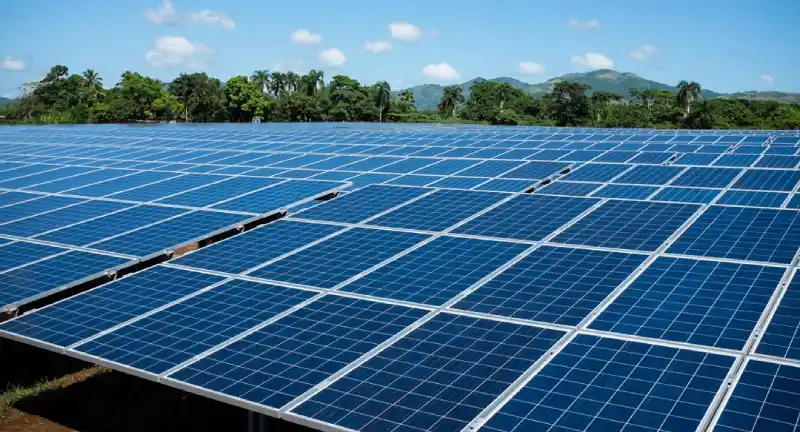Since the innovation of harnessing solar energy has been a success, people have opted to use solar power for various purposes for households, businesses, commercial spaces, etc. It is not only pocket-friendly but also efficient, sustainable, and environmentally friendly, as sunlight is a natural resource that is available abundantly and is replenishable.
This innovation has helped greatly in reducing carbon emissions and the abuse of fossil fuels, as well as in achieving affordable and industrial growth. We see and use solar in our everyday lives but have a vague idea about how the sun’s energy is converted into electricity from solar PV panels. In this blog, we will discuss the process of converting sunlight into electricity from PV panels.
What Are Solar PV Panels?
Solar power is a renewable source of energy that is radiated from the sun and can be converted into usable energy using solar panels. Solar power is a clean and sustainable alternative solution to fossil fuel and can reduce carbon footprint and greenhouse emissions.
Solar panels are devices that harness solar power to generate electricity using photovoltaic (PV) cells. The photovoltaic cells absorb the sunlight when it falls onto the solar panels, creating energy that creates electrical charges that move in response to the electrical field in the cell. Let us know in a more detailed version.
Converting Solar Energy Into Electricity Using PV Panels
The process of converting solar energy into electricity is a very delicate yet simple process. In this process, you can witness the wonders of modern technology and how you can harness the power of the sun and use it as electricity in your daily lives.
Capturing Sunlight
Solar panels or Photovoltaic (PV) panels are made up of tiny solar cells or PV cells where sunlight is absorbed during the daytime, which is composed of tiny particles called photons. Each solar cell has a thin semiconductor wafer that is made up of two layers of silicon. Silicon is a natural semiconductor that can be used as both a conductor and an insulator.
Electron Excitation
When sunlight hits the solar cells, the photons transfer their energy to the electrons in the cells’ material. This excites the electrons, causing them to break free from the atoms.
Electron Flow
The excited electrons move through the material of the solar cell, creating a flow of electric current. This flow of electrons is directed by the built-in electric field in the solar cell creating an electric current.
Electrical Conversion
The flow of electrons is then harnessed and converted into usable electricity. The solar panels are connected to an inverter, which converts the direct current (DC) electricity produced by the panels into alternating current (AC) that can be used to power homes and buildings.
Utilisation And Storage
The generated electricity can now be used to power various devices and appliances if you produce more electricity than you can consume. It can be fed back to the grid for others to use. Additionally, excess electricity can be stored in batteries for later use. Allowing you to have electricity even when the sun is not shining.
Advantages Of Solar Energy
As society is advancing towards sustainable growth, there is an emerging need for a mass shift to this renewable energy source. The advantages of solar power mentioned below can convince you to take the first step towards using this clean and green energy.
Renewable And Sustainable
Solar power is derived from the sun, which is an abundant and renewable energy source. As long as the sun contributes to shine, we can harness its energy for power generation, making it renewable and sustainable.
Environmental Friendly
Solar power is a green and clean energy source. Unlike fossil fuels, it produces no greenhouse gas emissions or pollutants during operation. By using solar power, we can reduce carbon emissions and combat climate change.
Energy Independence
Solar energy allows individuals and communities to become more energy-independent. By generating electricity on-site, you can reduce reliance on the grid and potentially lower your energy bills. It also provides electricity in remote areas where grid connectivity is limited.
Long-Term Cost Saving
While the initial installation cost may be higher, solar power offers long-term cost savings. Once installed, you can generate electricity at practically zero cost, and the maintenance expense is relatively low. This will save you utility bills in the long run.
Reduced Dependence On Fossil Fuels
Solar power reduces our dependency on finite fossil fuel resources. Transitioning to solar power will reduce our reliance on non-renewable energy, leaving more fossil fuels for future generations.
Conclusion
Mankind has been using solar energy directly or indirectly for a very long time. Sunlight has been harnessed from PV (photovoltaic) panels since the 1950s after the development of solar PV cells. In most cases, solar panels are located on the roof of any building or open spaces where sunlight reaches abundantly. Hence, it is through these solar PV panels that we can harness solar energy.
These solar panels are usually southern-faced for maximum potential and electricity production. Each is made up of a special layer of silicon cells, a metal frame, and a glassed casing, which is further surrounded by special film and wiring. If you also want the best solar panels, then Inter Solar Systems (since 1997) is the place where you will get it all. Contact us today to learn more about our complete range of solar panels.

